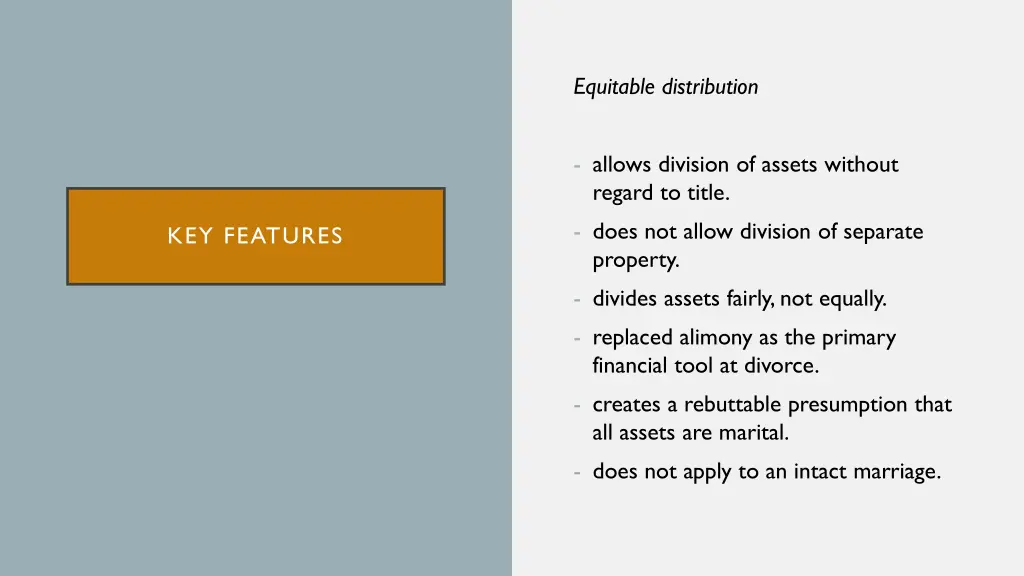
Equitable Distribution in Divorce: Key Features and Process Explained
Learn about equitable distribution in divorce, a financial tool replacing alimony. Discover how assets are divided fairly, not equally, based on Ferguson factors, and the distinction between marital and separate property.
Download Presentation

Please find below an Image/Link to download the presentation.
The content on the website is provided AS IS for your information and personal use only. It may not be sold, licensed, or shared on other websites without obtaining consent from the author. If you encounter any issues during the download, it is possible that the publisher has removed the file from their server.
You are allowed to download the files provided on this website for personal or commercial use, subject to the condition that they are used lawfully. All files are the property of their respective owners.
The content on the website is provided AS IS for your information and personal use only. It may not be sold, licensed, or shared on other websites without obtaining consent from the author.
E N D
Presentation Transcript
Equitable distribution - allows division of assets without regard to title. - does not allow division of separate property. KEY FEATURES - divides assets fairly, not equally. - replaced alimony as the primary financial tool at divorce. - creates a rebuttable presumption that all assets are marital. - does not apply to an intact marriage.
EQUITABLE DISTRIBUTION STEPS 1. Classify assets as separate or marital. 2. Value all assets. 3. Divide marital assets based on Ferguson factors. 4. If one spouse is left with a deficit, consider alimony. Ferguson v. Ferguson, 639 So. 2d 921 (Miss. 1994).
MARITAL PROPERTY DEFINED Marital property includes [a]ssets acquired or accumulated during the course of a marriage [unless] such assets are attributable to one of the parties' separate estates prior to the marriage or outside the marriage. An alternative: Marital property includes any property acquired or value created through the efforts of one of the spouses during the marriage. Hemsley v. Hemsley, 639 So. 2d 909, 914 (Miss. 1994).
SEPARATE PROPERTY Separate property includes - gifts and inheritances, - passive appreciation on separate property, - property acquired before marriage, - property acquired after the marital property cutoff date, and - property excluded by agreement.
Other jurisdictions have held that assets acquired during cohabitation prior to marriage are not subject to equitable distribution. . . . There have been exceptions where it was proven that certain property was specifically acquired in contemplation of marriage. Berrie v. Berrie, 252 N.J.Super. 635, 600 A.2d 512, 518 (1991); Raspa v. Raspa,207 N.J.Super. 371, 504 A.2d 683 (1985). PROPERTY ACQUIRED IN CONTEMPLATION OF MARRIAGE Bunyard v. Bunyard, 828 So. 2d 775, 777 (Miss. 2002).
Prior to 2013, marital property accumulation ceased - upon entry of a separate maintenance order, Godwin v. Godwin, or - upon entry of a temporary support order, Pittman v. Pittman. PRE-COLLINS DEMARCATION RULES In the absence of a separate maintenance or temporary support order, marital property accumulation ended at divorce.
MARITAL PROPERTY CUTOFF DATE Temporary support orders are no longer an automatic line of demarcation. Financial interdependence is a significant factor greater dependence suggests a later cutoff date. Separate maintenance orders may still be a demarcation point. Assets acquired after cutoff with marital funds are marital.
An asset acquired through a loan is marital if - the loan was secured by marital assets; - the other spouse was liable on the loan; OR ASSETS ACQUIRED WITH LOANS - the loan was repaid using marital funds.
APPRECIATION IN SEPARATE PROPERTY ASSETS Appreciation in a separate property asset may be separate or marital. Classification of appreciation is determined by the active-passive rule: If the appreciation is active (caused by a spouse s efforts) the appreciation is marital. If the appreciation is passive (caused by other forces) the appreciation is separate.
ACTIVE AND PASSIVE APPRECIATION Marriage Jan. 1, 2010 ________________ _____________________________________ _________________________ June 30, 2020 Dec. 31, 2022 Separation Divorce H retirement: $30,000 No new contributions H retirement: $55,000 W business: $100,000 W works in business W s business :$250,000 H land: $300,00 H savings: $30,000 No payment H land: $500,00 Deposits from income: $50,000 Deposits: $10,000 H s retirement: W s business: H s land: $200,000 passive appreciation $25,000 passive appreciation $150,000 active appreciation -.
ACTIVE AND PASSIVE APPRECIATION Marriage Jan. 1, 2010 ________________ _____________________________________ _________________________ June 30, 2020 Dec. 31, 2022 Separation Divorce H retirement: $30,000 No new contributions H retirement: $55,000 W business: $100,000 W works in business W s business :$250,000 H land: $300,000 H savings: $30,000 No payment H land: $500,000 Deposits from income: $50,000 Deposits: $10,000 H s retirement: W s business: H s land: $200,000 passive appreciation $25,000 passive appreciation $150,000 active appreciation -.
ACTIVE AND PASSIVE APPRECIATION Marriage Jan. 1, 2010 ________________ _____________________________________ _________________________ June 30, 2020 Dec. 31, 2022 Separation Divorce H retirement: $30,000 No new contributions H retirement: $55,000 W business: $100,000 W works in business W s business :$250,000 H land: $300,000 H savings: $30,000 No payments H land: $500,00 Deposits from income: $50,000 Deposits: $10,000 H s retirement: W s business: H s land: $200,000 passive appreciation $25,000 passive appreciation $150,000 active appreciation -.
MIXED ASSETS Marriage Jan. 1, 2010 ________________ _____________________________________ _________________________ June 30, 2020 Dec. 31, 2022 Separation Divorce H retirement: $30,000 No new contributions H account $55,000 W business: $100,000 W works in business W s business :$250,000 H land: $300,000 Land rented for farming H land: $500,00 H savings: $30,000 Contributed $50,000 Contribute $10,000 H s retirement: W s business: H s land: H s savings account: Classification: Mixed asset ($40,000 SP; $50,000 MP) Classification: All separate property (premarital, passive appreciation) Classification: Mixed asset ($100,000 SP; $150,000 MP) Classification: All separate property (premarital, passive appreciation) -.
EXCEPTIONS TO FAMILY USE In some cases, courts classify a premarital home as separate, without discussion of the family use doctrine. treat the home as a mixed asset, allowing the separate property owner to trace the separate portion. Classify a home as marital but award the owning spouse most of the equity. \ disregard family use because of the short length of the marriage.
USE OF ACCOUNT FUNDS Mississippi rule: Exception; Pettersen v. Pettersen: A husband s use of separate retirement funds for family purposes converted the appreciated value to marital. (Also finding that the appreciation was caused by his active management of the retirement account). - Using funds from an account for family purposes does not convert the underlying account to marital. - Only the funds used are converted to marital.
MIXED ASSETS Marriage Jan. 1, 2010 ________________ _____________________________________ _________________________ June 30, 2020 Dec. 31, 2022 Separation Divorce H retirement: $30,000 No new contributions H account $55,000 W business: $100,000 W works in business W s business :$250,000 H land: $300,000 Land rented for farming H land: $500,00 H savings: $30,000 Contributed $50,000 Contribute $10,000 H s retirement: W s business: H s land: H s savings account: Classification: Mixed asset ($40,000 SP; $50,000 MP) Classification: All separate property (premarital, passive appreciation) Classification: Mixed asset ($100,000 SP; $150,000 MP) Classification: All separate property (premarital, passive appreciation) -.
CONVERSION BY COMMINGLING The commingling rule does not apply to The commingling rule does apply to - Real property, including the marital home - Most tangible assets - Retirement accounts - Investment accounts - Businesses - Bank accounts
MIXED ASSETS Marriage Jan. 1, 2010 ________________ _____________________________________ _________________________ June 30, 2020 Dec. 31, 2022 Separation Divorce H retirement: $30,000 No new contributions H account $55,000 W business: $100,000 W works in business W s business :$250,000 H land: $300,000 Land rented for farming H land: $500,00 H savings: $30,000 Contributed $50,000 Contribute $10,000 H s retirement: W s business: H s land: H s savings account: Classification: Mixed asset ($40,000 SP; $50,000 MP) CONVERTED TO MP BY COMMINGLING Classification: All separate property (premarital, passive appreciation) Classification: Mixed asset ($100,000 SP; $150,000 MP) NOT CONVERTED BY COMMINGLING Classification: All separate property (premarital, passive appreciation) -.
In spite of the commingling rule, some cases have allowed tracing of separate funds in real property or bank accounts, including MIXED ASSET TRACING PERMITTED - the marital home, Delk v. Delk, 41 So. 3d 738, 740 (Miss. Ct. App. 2010); - other real property, Dorsey v. Dorsey, 972 So. 2d 48, 52 (Miss. Ct. App. 2008); and - bank accounts, Oliver v. Oliver, 812 So. 2d 1128, 1134 (Miss. Ct. App. 2002).
1. When was an asset acquired prior to the marriage, during the marriage, after the marriage? Identify the periods during which value accumulated. If the asset was acquired during the marriage, was it acquired with spousal efforts? Does the asset include appreciation during the marriage? If so, determine whether it is active or passive. Is the asset mixed, party separate and partly marital? Identify the separate and marital portions. If the asset is mixed, has it been converted to marital by commingling? If the asset is separate or mixed, has it been converted to marital by family use? 2. SUMMARY 3. 4. 5. 6.






















